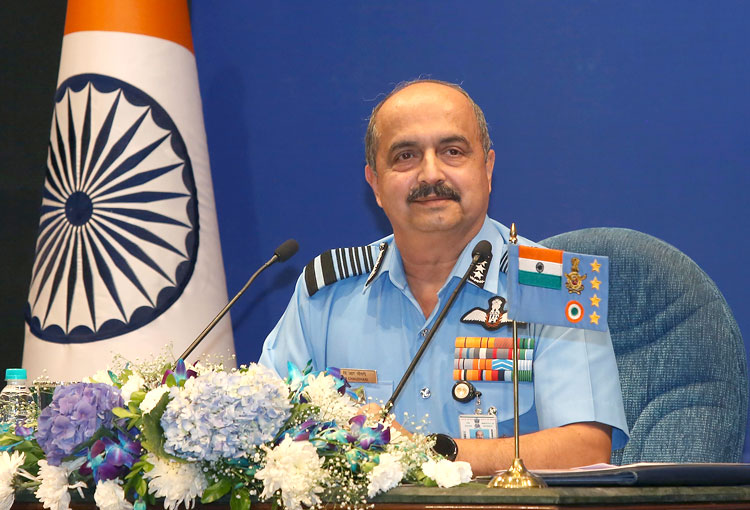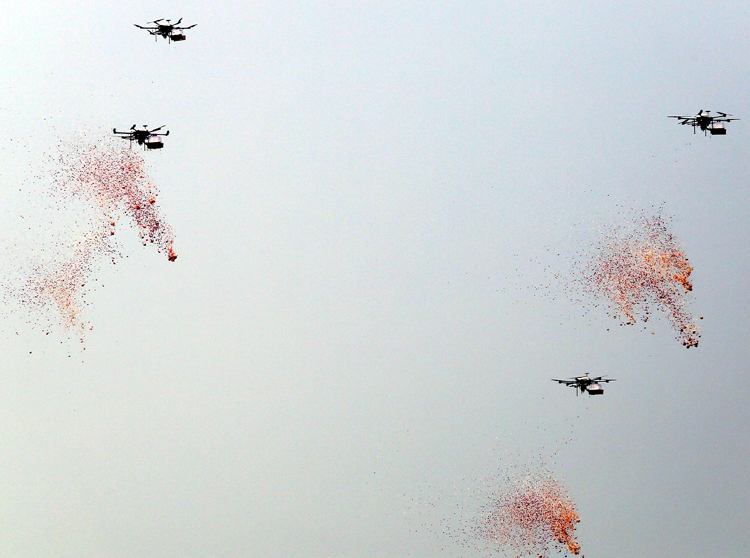INDIAN ARMED FORCES CHIEFS ON
OUR RELENTLESS AND FOCUSED PUBLISHING EFFORTS

SP Guide Publications puts forth a well compiled articulation of issues, pursuits and accomplishments of the Indian Army, over the years

I am confident that SP Guide Publications would continue to inform, inspire and influence.

My compliments to SP Guide Publications for informative and credible reportage on contemporary aerospace issues over the past six decades.
IAF will not be able to get authorised fighter strength of 42 squadrons: Air Chief
Best case scenario is 35 fighter squadrons after 15 years

India's new Chief of the Air Staff Air Chief Marshal VR Chaudhari made a rare public acknowledgement that the Indian Air Force (IAF) will have to operate way below its authorised fighter strength of 42 squadrons for at least the next 15 years, even as it braces up to face the threat of a two-front war and new age military challenges.
"We will not be able to equip (the IAF) with 42 squadrons in the next 10-15 years. Four squadrons of the Light Combat Aircraft (LCA) Mk 1A, 6-7 of the Advanced Medium Combat Aircraft (AMCA), 6 squadrons of the Multi-Role Fighter Aircraft (MRFA) will be added. Four squadrons of the MiG-21, and the Jaguars and MiG-29 (fleets) will be phased out. Our numbers will stay about 35 squadrons. At the moment, there's no hope of the squadron strength going up beyond this number," Air Chief Marshal Chaudhari admitted, while doing some candid arithmetic about the likely additions and deletions from the IAF fleet of fighter aircraft in the foreseeable future.
The Air Chief also disclosed that the IAF is down to its last four squadrons of the MiG-21, which for decades was the mainstay of the force. The drawdown plan has been forced to extend the life of the MiG-21 in the IAF by another four years to partially make up for the shortfall in numbers. The MiG-21 has become the symbol of obsolescence of a significant part of the Indian weaponry
Air Chief Marshal Chaudhari, who took over as the Chief of the Air Staff on September 30, 2021, made these comments at a press conference in New Delhi on October 5 ahead of the 89th Air Force Day on October 8.
The IAF's current squadron strength is down to a reported 30. Each squadron is meant to be equipped with 18-to-20 fighter aircraft. The IAF is betting big on India's Defence and Aerospace Industry and the Defence Research and Development Organisation to get to even 35 squadrons. The Made-in-India story has so far been defined by delays and failure but there's hope for a turnaround.
India to ramp up non-kinetic warfare capability
In response to a question by Jayant Baranwal, Editor-in-Chief, SP Guide Publications, Chief of the Air Staff Air Chief Marshal V.R. Chaudhari emphasised preparedness to face new military threats
Jayant Baranwal: What is your wholistic vision for our Air Force and the overall strategy?
Air Chief Marshal VR Chaudhari: The future of warfare is going to be multi-domain, not merely restricted to kinetic warfare. So, our strategy should be to undertake simultaneous and parallel operations, both kinetic and non-kinetic. Our emphasis would be on cyber warfare, mitigating cyber attacks and carrying out parallel cyber attacks along with kinetic warfare. The induction of new generation platforms, fifth generation technologies is an achievable goal in the next decade or so.
"The delivery of 83 LCA Mk 1A will start in 2024. The IAF is committed to the (futuristic fifth generation fighter) Advanced Medium Combat Aircraft (AMCA). There's an aggressive deadline for the AMCA. We're hoping to begin inductions by early next decade. To mitigate the gap, we have a RFI for 114 MRFA," the IAF Chief said.
The IAF will be hamstrung by the shortfall in numbers at a time when India faces not just the prospect of a two-front war but also a host of new challenges "which open up new battlespace". Air Chief Marshal Chaudhari mentioned drone swarms, directed energy, cyber warfare and non-kinetic weapons as requirements to defeat new threats, even as he expressed the hope that the induction of fifth generation technology is "achievable in the next decade".
Repeatedly stressing on the requirement of drone swarming and counter-drone technologies, the IAF Chief disclosed that a contract for drone swarms will be signed soon with an Indian start-up
The IAF fleet is a staggering mix ranging from legacy Soviet era MiGs and a limited number of contemporary four-and-a-half generation Rafale fighters.
The Air Chief also disclosed that the IAF is down to its last four squadrons of the MiG-21, which for decades was the mainstay of the force. The drawdown plan has been forced to extend the life of the MiG-21 in the IAF by another four years to partially make up for the shortfall in numbers. The MiG-21 has become the symbol of obsolescence of a significant part of the Indian weaponry.

Air Chief Marshal Chaudhary also said that the S-400 surface-to-air missiles "will be inducted this year" to beef up India's air defences.
Repeatedly stressing on the requirement of drone swarming and counter-drone technologies, the IAF Chief disclosed that a contract for drone swarms will be signed soon with an Indian start-up.
He also said that "we're on the verge of procuring the first six (indigenous) Light Utility Helicopters (from HAL)" and that the technical evaluation of the Ka-226 had been completed. The Army is the lead agency in the procurement of the Russian-origin Ka-226
He also said that "we're on the verge of procuring the first six (indigenous) Light Utility Helicopters (from HAL)" and that the technical evaluation of the Ka-226 had been completed. The Army is the lead agency in the procurement of the Russian-origin Ka-226.
The procurement of the ISTAR surveillance and targeting aircraft is being processed with the US on a government-to-government level under the Defence Technology and Trade Initiative (DTTI).
The Air Chief also said that the case for procuring 6 Mid-Air Refuellers was at the Air Staff Quality Requirements (ASQR) stage.
Clarifying the move to purchase used Mirage-2000 aircraft from France, he said this was being done to harvest spares to keep the IAF's Mirage fleet flying.





